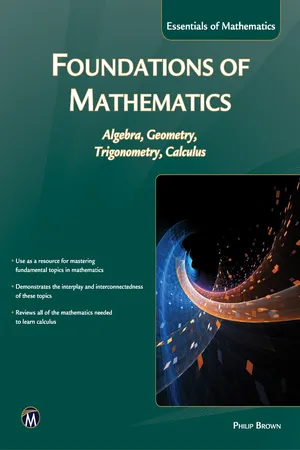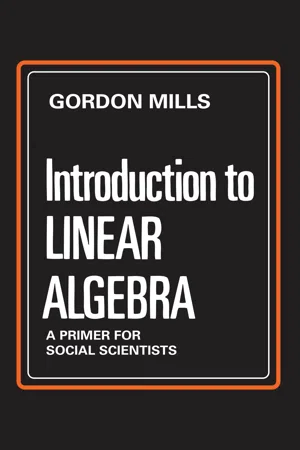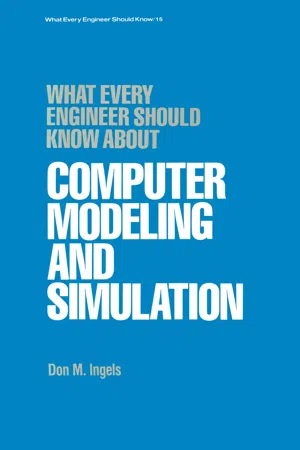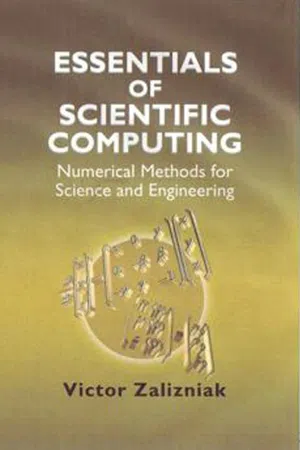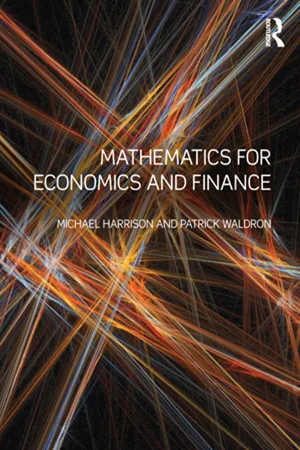Mathematics
Solving Linear Equations
Solving linear equations involves finding the value of the variable that makes the equation true. This is typically done by performing operations to isolate the variable on one side of the equation. The goal is to simplify the equation to the form "variable = value" or "value = value," allowing for the solution to be easily determined.
Written by Perlego with AI-assistance
Related key terms
9 Key excerpts on "Solving Linear Equations"
- eBook - ePub
- Oleksandr Kaleniuk(Author)
- 2023(Publication Date)
- Manning(Publisher)
Geometry stands privileged among other mathematical disciplines: it not only relies on linear equations to solve its own problems, but also gives these equations a geometrical meaning, allowing us to understand them through plots and graphics. The most obscure algorithms become comprehendible when you see them in action. This understanding, obtained by watching them work, also helps us competently choose the best algorithms to solve our problems.3.1 Linear equations as lines and planes
A linear equation is a sum of variables multiplied by some coefficients that equals some number. The variables may occur only in power 1. Having an x2 in an equation, for example, disqualifies it as linear, making it quadratic instead. Grouped together, linear equations form a system of linear equations.A solution to a linear system is a set of variables’ values for which all the equations hold. Depending on the system, there could be a single combination, a whole class of them, or none at all. Sometimes, a solution exists, but we have trouble finding it numerically. Sometimes, there are no solutions mathematically, but the one we compute despite its theoretical impossibility is good enough for our needs. Everything depends on the system.This dependency, however, isn’t immediately apparent when all we see are equations made of numbers and letters. But if we rewrite them as geometrical entities, we literally see which systems are easy to solve and which are not.3.1.1 Introducing a hyperplane
This is a linear equation of two variables, x and y:ax + by = cIf we move the coefficient from the right side to the left side, we getax + by - c = 0Never mind the minus sign; this equation is a line equation in 2D. So a linear system of two equations is essentially a system of two lines. The solution to this system is the point where the lines intersect.Awesome! Now we can take our two-trains problem from before and draw it (figure 3.1):Vp - 2Va = 0Va + Vp - 450 = 0Figure 3.1 The two-trains problem as an intersection of lines The solution is immediately apparent: It’s where the lines intersect. In figure 3.1, the solution is the point (300, 150). We can do the same thing in 3D. A linear equation like this - eBook - ePub
Foundations of Mathematics
Algebra, Geometry, Trigonometry and Calculus
- Philip Brown(Author)
- 2016(Publication Date)
- Mercury Learning and Information(Publisher)
section 3.9 rather challenging. However, it is natural to move on to the problem of solving cubic, quartic, and quintic equations. In fact, the study of algebra is not complete without it!3.2Solving Linear Equations
Our plan of action is to begin in the most basic situation, which is to solve a linear equation. Here is a simple problem that leads to a linear equation:EXAMPLE 3.2.1. What number when multiplied by 3 is equal to that number plus 8?Answer: If we denote the unknown value as x, then the problem can be restated in the form: for what value of x is the equation3x = x + 8a true statement?The answer can be obtained by solving the equation. The way to do this is to isolate x on one side of the equation by applying the same algebraic operations to each side of the equation. First, subtract x from each side of the equation:3x − x = (x + 8) − x.Each side of the equation can be simplified, and the result is2x = 8.Next, we divide each side of the equation by 2: to obtain the answerx = 4.Problems of this type have been solved since the times of the earliest known human civilizations. Here is a problem from the Rhind papyrus, an Egyptian mathematical text containing 85 problems copied by the scribe Ahmes in about 1650 BC.EXAMPLE 3.2.2. A quantity, its 2/3, its 1/2, and its 1/7, added together, becomes 33. What is the quantity?Answer: We solve this once again, by denoting the unknown quantity as x and writing the statement of the problem as an equation:The way to proceed from here is a matter of choice, but the easiest way to isolate x is to multiply each side of the equation by the lowest common multiple of 2, 3, and 7, which is 42. Thus,By expansion of the left side of the equation, this becomes42x + 28x + 21x + 6x = 1,386which simplifies to97x = 1,386.The final answer isSome equations might not be linear to begin with but after some simplifications or reductions have been carried out, the answer can be obtained by solving a linear equation. Here are two examples of this: - eBook - ePub
- Toby Wagner(Author)
- 2021(Publication Date)
- Chemeketa Press(Publisher)
Chapter 2 , we learned that a linear equation in two variables has infinitely many solutions. In other words, there are infinitely many combinations of variable values (ordered pairs) that will make the equation true. When graphed, all of the solutions make a straight line.If we need to find a particular solution, then we must be given more than one equation.Here is a problem like that:This problem may seem confusing and raise a lot of questions: Exactly what does “solve” mean in this case? How can we solve more than one equation at a time? How can we solve anything by graphing? Before tackling this problem, we need to understand systems of equations and revise our definition of the word “solution.”After completing this section, you should be able to: ◆ Recognize a system of equations and a solution for a system of equations ◆ Graphically interpret systems with one solution, no solution, or infinitely many solutions ◆ Solve a system of linear equations graphically — by hand and with a graphing calculatorA. Solution of a System
A set of two linear equations using two variables is called a system of linear equations in two variables. For short, we can call it a system of equations. For example, this pair of equations is a system of equations:The big, curvy grouping symbol to the left of the equations is called a brace, and it’s used to show that the two equations occur together and at the same time.Before we move forward, let’s remember a couple of things from Chapter 2 :◆ We know that an ordered pair is a set of two numbers that are written in a particular order. They are written in parentheses, like this: (2, 7). In this case, the first number, 2, represents the x - eBook - ePub
Introduction to Linear Algebra
A Primer for Social Scientists
- Gordon Mills(Author)
- 2017(Publication Date)
- Routledge(Publisher)
CHAPTER 6The solution of simultaneous linear equations6.1 Introduction
One of the most Important and most common types of calculation in linear algebra is the solution of a system of simultaneous linear equations. We have already had occasion (in section 3.11 for example) to write out a general system of m equations involving n variables denoted x j for j = 1, …., n ; such a system may be written out in full:a 11x 1+a 12x 2+ … . +a1 nx n=b 1a 21x 1+a 22x 2+ … . +a2 nx n=b 2. ⋮am 1x 1+am 2x 2+ … . +am nx n=b mIf the vectors x and b and the matrix A are defined in the obvious way, then the system can be written :Ax = bIn this chapter, we shall be concerned with whether or not such a system has a solution in any particular case, and (above all) with the computation necessary to find a solution.By ‘a solution’ we mean a set of numerical values, one for each of the variables, such that each of the equations is satisfied by this set of values. It is for this reason that we speak of a system of simultaneous equations – one and the same set of values must simultaneously satisfy every equation in the system. As pointed out in section 1.1 , an applied context may require the variables to be confined to non-negative values, and may even rule out all but integer values. In this chapter, it is supposed that the analysis may be conducted in terms of continuous variables (and that If necessary in an applied context, any fractional values may be rounded off at the end of the calculation). As far as the mathematical analysis is concerned, It is also supposed that in a solution to a system of equations, the variables may take on any values, positive or negative, Integer or fractional ; this is the supposition under which we will ascertain whether or not a system of equations has a solution. In applying this analysis to particular contexts, It will sometimes be necessary to rule out negative values; and even if a solution exists in the sense previously Indicated, It does not necessarily follow that a non-negative solution exists. (The circumstances In which it is necessary to conduct the analysis In terms of integer variables right from the outset will be discussed briefly in Chapter 7 - eBook - ePub
Linear Algebra
An Inquiry-Based Approach
- Jeff Suzuki(Author)
- 2021(Publication Date)
- CRC Press(Publisher)
2Systems of Linear Equations
In this chapter, we’ll consider the problem of solving systems of linear equations. This is a critical part of linear algebra, and we offer the following general strategy:Strategy. Every problem in linear algebra begins with a system of linear equations.2.1 Standard Form
When trying to work with a collection of objects, it’s easiest if they’re all in some standardized format. You’ve seen such standardized formats before: it’s convenient to rewrite a given quadratic equation in the forma; it’s convenient to write the equation of a line in the formx 2+ b x + c = 0y = m x + b; and so on. In this activity, we’ll develop a standard form for a system of linear equations.Activity 2.1: Standard Form We’ll say that an equation has been reduced to simplest form if it has as few terms as possible.A2.1.1 The equation3 x − 5 y = 8has three terms: 3x, 5y, and 8. If possible, rewrite the equation so it has fewer terms; if not possible, explain why not.A2.1.2 The equation2 x + 7 z = 1 + 2 y + 5 xhas five terms. If possible, rewrite the equation so it has fewer terms; if not possible, explain why not.A2.1.3 The equation5 x − 2 y + z + 12 = 0has five terms. If possible, rewrite the equation so it has fewer terms; if not possible, explain why not.Activity 2.1 motivates the following definition:Definition 2.1 (Standard Form). A linear equation is in standard form when- All of the variables are on one side of the =,
- The constant is on the other side of the =.
As Activity 2.1 shows, equations in standard form will have fewer terms than equations not in standard form.In Activity A1.3.2, we represented linear equations as vectors. If we have a system of equations, we can represent the entire system as a collection of vectors and, as long as all - Don M. Ingels(Author)
- 2021(Publication Date)
- CRC Press(Publisher)
SOLVING THE MATHEMATICAL MODELThough this be madness, yet there be method in’t.[Shakespeare]5.1 INTRODUCTIONAs mentioned in Chapter 2 , writing down a set of equations might constitute a model, but equations are of little use unless they can be solved. The two basic solution approaches are: (1) analytical and (2) numerical. The analytical techniques are more informative and efficient to use, but much less general in their range of applicability, i.e., it is common to have equations with no known explicit analytic solution. These will be left to texts on mathematics [13 , 14 ]. Because of their general usefulness, the material in this book is restricted to a discussion of some useful numerical procedures that are commonly used in computer simulations.Two different classes of problems are encountered when modeling systems with sets of equations, whether the equations are linear or nonlinear. These two categories are:- n equations in n unknowns
- m equations in n unknowns, m < n
with k inequalities in n unknowns, where k can be any number. If the equations in class 1 problems are independent, they can usually be solved by methods such as those described below. Class 2 problems are solved using optimization techniques, linear programming [1 ] for linear systems, and nonlinear programming techniques [2 , 3 , 7 ] for nonlinear systems.
A set of linear equations can be written as:5.2 LINEAR ALGEBRAIC SYSTEMS(5.1)a11x 1+a12x 2+ ⋯ +a1 nx n=b 1a21x 1+a22x 2+ … +a2 nx n=b 2⋮an 1x 1+an 2x 2+ … +an nx n=b nwhere x1 … xn are the n unknowns, aij are known coefficients, and bi are known constants.If the number of equations is large, somewhere over four, writing them out explicitly soon becomes tedious and then they are most frequently expressed in array notation in terms of a matrix A and two vectors, x and b.- eBook - ePub
Essentials of Scientific Computing
Numerical Methods for Science and Engineering
- Victor Zalizniak(Author)
- 2008(Publication Date)
- Woodhead Publishing(Publisher)
3Solving systems of linear equations
This chapter considers one of the cornerstones of numerical analysis, namely, solving systems of linear equations. Various properties of systems of linear equations (such as structure, definiteness, and conditionality) are discussed. The main principles of direct methods are considered briefly, just to provide the information needed to use modern software. Particular emphasis is placed on the iterative methods because, in many instances, they are more efficient than the direct methods.Notation A ={ anm}matrix (uppercase bold letter) x vector (lowercase bold letter) N matrix or vector size ||·|| matrix or vector norm A T , x T transposed matrix or vector (x , y )=x T y dot product of vectors x and y SPD symmetric positive definite (matrix) det(A ) matrix determinant diag(a 1 , …, aN)diagonal matrix with elements a 1 , …, aNI identity matrix (I =diag(l, …, 1)) A −1 inverse matrix (A −1 A =I ) ɛpprescribed accuracy for calculating the approximate solution epperturbation error eaalgorithm error e τ rounding error x* true solution of a linear system (Ax*≡f ) x (k )k th approximation to the true solution e (k )= x* −x(k )error of k th approximation r (k )=Ax(k )−fresidual vector z n (B ) n th eigenvector of matrix B λn(B )n th eigenvalue of matrix B s (B )=max| λn(B )|spectral radius of matrix B N ops total number of operations (additions and multiplications/divisions) required to solve a system of linear equations 3.1 LINEAR ALGEBRA BACKGROUND
To begin with, we will consider some basic definitions from linear algebra needed for understanding of matrix computations. We will restrict our consideration to the case when matrices and vectors are real. Vectors, then, are objects of the N-dimensional Euclidean spaceRN. A list of the operations defined inRN - eBook - ePub
- Michael Harrison, Patrick Waldron(Authors)
- 2011(Publication Date)
- Routledge(Publisher)
Systems of linear equations and matrices
DOI: 10.4324/9780203829998-31.1 Introduction
This chapter focuses on matrices. It begins by discussing linear relationships and systems of linear equations, and then introduces the matrix concept as a tool for helping to handle and analyse such systems. Several examples of how matrices might arise in specific economic applications are given to motivate the mathematical detail that follows. These examples will be used again and further developed later in the book. The mathematical material that follows the examples comprises discussions of matrix operations, the rules of matrix algebra, and a taxonomy of special types of matrix encountered in economic and financial applications.1.2 Linear equations and examples
Linear algebra is a body of mathematics that helps us to handle, analyse and solve systems of linear relationships. A great deal of economics and finance makes use of such linear relationships. A linear relationship may be represented by an equation of the formwhere x, y and z are variables and α and ß are constants. Such relationships have several nice properties. One is that they are homogeneous of degree one, or linearly homogeneous, i.e. if all variables on the right-hand side are scaled (multiplied) by a constant, θ, then the left-hand side is scaled in the same way. Specifically, using (1.1 ), we havez = α x + β y1.1z * = α1.2(+ βθ x)(= θθ y)(= θ zα x + β y)Another property of linear relationships is that, for different sets of values for their variables, they are additive and their sum is also linear. Suppose we have the two equations z1 = αx1 + ßy1 and z2 = αx2 + ßy2 , then1.3 after slight rearrangement, which may be written asz 1+z 2= α(+ β)x 1+x 2()y 1+y 2Z = α X + β Y1.4 where X = x1 + x2 , Y = y1 + y2 and Z = z1 + z2 . The result, equation (1.4) , is a linear equation in the sums of the respective variables. The generalization to the case of n equations is straightforward and hasX =., Y∑i = 1nx iand Z =∑i = 1ny i∑i = 1nz iThese simple properties constitute one reason why linear relationships are so widely used in economics and finance, and particularly when relationships, such as demand and supply curves, are first introduced to students.1 - eBook - ePub
- James R. Kirkwood, Bessie H. Kirkwood(Authors)
- 2020(Publication Date)
- Chapman and Hall/CRC(Publisher)
A system of linear equations that has either exactly one solution or infinitely many solutions is said to be consistent. A system of linear equations that has no solutions is inconsistent. We give an example of each possibility.Example For the systemThe system of equations2 x − 3 y = 5x + 3 y = − 2there is exactly one solution, namely x = 1, y = −1. The graph of the system of equationsFigure 2.1 Systems of linear equations with (a) no solution and (b) one solution.2 x − 3 y = 53 x − y = 4x + y = 1is shown in Figure 2.1 (a.). Since there is no point where the graphs of all three equations meet, there is no solution to the system of equations. Figure 2.1(b.) shows a system of three equations with exactly one solution.x + y = 3x + y = 4obviously has no solution. The graph is shown in Figure 2.2 (a.). The system of equationsFigure 2.2 (a) A system of equations with no solution. (b) A system of equations with infinitely many solutions.x + y = 32 x + 2 y = 6has infinitely many solutions. The graph is shown in Figure 2.2 (b.).A special and important class of systems of linear equations that always have at least one solution is the class of homogeneous equations. These are systems where every bi= 0. One solution to such a system will always be when each variable is 0. This means for a system of two or three variables, the graph of each equation in a homogeneous system passes through the origin.Solving Systems of Linear Equations
The most common way of solving a system of linear equations is to convert the given system to an equivalent system where the solution to the equivalent system is obvious. By “an equivalent system” we mean that the two systems have the same variables and the same solution set.Most often, the solution to a system of linear equations is found by a computer. We demonstrate below how to find the solution by hand. A computer program uses a very similar technique but, of course, is much more rapid.
Index pages curate the most relevant extracts from our library of academic textbooks. They’ve been created using an in-house natural language model (NLM), each adding context and meaning to key research topics.

